1544 Search Results for link up
September 19, 2018
by Carole Zangari -

Since 1992, a highlight of the ISAAC Biennial Conferences has been the presentation of the Outstanding Consumer Lecture Award. This award is given to a person who uses AAC to share their talents, perspectives, and experiences. In this week’s featured video, we hear from the most recent awardee, Mke Ninces, on Assumptions, Attitudes, and Adventures. Congratulations to Ms. Ninces on receiving the 14th ISAAC Outstanding Consumer Lecture Award, and thank you to ISAAC for hosting and sharing this lecture. Direct Link to Video: https://www.youtube.com/watch?v=psbtJNNFL7I
September 13, 2018
by Carole Zangari -
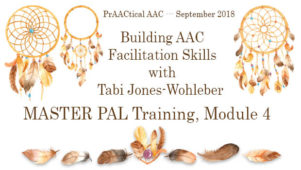
Ready for more AAC training materials? In today’s post, Tabi Jones-Wohleber is sharing another module in the MASTER PAL series. This 30-minute session focuses on the role of multiple modalities in AAC. :::::::::::::::::::::::::::::::::::::::::::::::::::::::::::::::::::::::::::::::::::::::::::::::::::: Model as a MASTER PAL Module 4: Accept Multiple Modalities Facilitator Guidelines We all use multiple modalities to communicate…speech, text, email, a gesture, facial expressions. In much the same way we encourage young children to interact by assigning meaning to their gestures, expressions, and utterances, responding meaningfully to the communicative attempts of those who use AAC validates and encourages the effort. Honor all modalities and respond by modeling AAC as much as possible(regardless of the modality used by the PWUAAC) teaches AAC. Seize the opportunity to teach and expand language. After all, multi-modal communication shapes the human experience. For this training you will need: The Presentation Slides The Presentation Handout The Facilitator’s Guide Warm-up Discussion: Thinking Prompt... [Read More...]
September 12, 2018
by Carole Zangari -
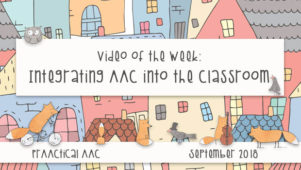
Here in the US, we’ve been back in school for a while and that makes it a good time to reflect on ways to integrate AAC into the classroom. Today’s video by Megan Conover as part of Saltillo’s webinar series. In this session, she covers some basic strategies that adults can use to help beginning AAC learners be successful in the classroom. Many thanks to Saltillo and Ms. Conover for creating, hosting, and sharing this archived presentation. Direct Link to Video – https://www.youtube.com/watch?v=bErjT5zi_9s
September 6, 2018
by Carole Zangari -
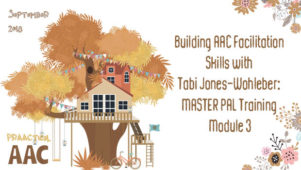
Our training series continues with West Virginia-based SLP Tabi Jones-Wohleber, who works with the AT Team for Frederick County Public Schools in Maryland and provides services to infants and toddlers in the West Virginia Birth to Three programs. In the first two posts, Tabi shared the Overview and Modeling modules and their accompanying resources. In today’s post, the training focuses on an important topic, motivation. ::::::::::::::::::::::::::::::::::::::::::::::::::::::::::::::::::::::::::::::::::::::::::::::::::::::::: Model as a MASTER PAL Module 3: Motivate Facilitator Guidelines Genuine motivation goes well beyond gummies and goldfish; reinforcers are only one small part of the picture as we endeavor to understand what truly drives an individual’s desire to learn and communicate. So much of the time it is the quality of the relationship and the meaningfulness of the interaction. This module discusses the importance of motivation in learning and engaging, whether intrinsic or extrinsic, as well as the undesirable consequences that occur when lack of motivation... [Read More...]
September 5, 2018
by Carole Zangari -
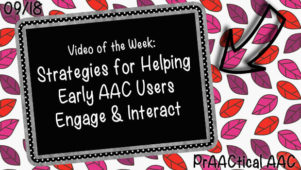
“He has an AAC device but he doesn’t use it much.” “I have great toys but she doesn’t seem to like any of them.” “How can I build language if he doesn’t want to interact with me?” “The only time she uses her SGD is to ask for things.” Connecting with clients who are beginning to use AAC and helping them use their communication tools is a challenge in some clinical and educational settings. Today, we revisit a session from CoughDrop’s 2nd Annual AAC in the Cloud conference held last spring, to get some prAACtical advice about building engagement and interaction. In our featured video, SLP Chana Feinstein of All Kinds of Voices provides concrete suggestions that will help our beginning communicators want to communicate and use their AAC devices for a variety of purposes. We are grateful to CoughDrop for hosting this wonderful conference and allowing us all to... [Read More...]
August 30, 2018
by Carole Zangari -
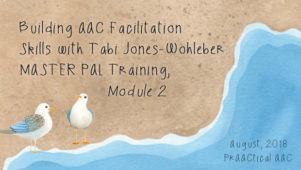
It’s a good day to talk training and we’re incredibly grateful to SLP Tabi Jones-Wohleber for sharing her partner training resources with us. In addition to her work with the AT Team for Frederick County Public Schools in Maryland, Tabi serves young children and their families at West Virginia Birth to Three programs. In the initial post, Tabi introduced the overview module and its accompanying resources. Today, we move onto Module 2 where the focus is on aided language input. ::::::::::::::::::::::::::::::::::::::::::::::::::::::::::::::::::::::::::::::::::::::::::::::::::::::::: Modeling AAC is unquestionably a key component of teaching AAC. Most frequenters of PrAACtical AAC understand that modeling is a naturalistic strategy that functions to support language development by SPEAKING YOUR WORDS. However, misconceptions abound, which often results in modeling opportunities characterized as imitation or compliance tasks. This module unpacks the imperative of modeling to provide a common understanding of what it is (and is not), and why it is a... [Read More...]
August 23, 2018
by Carole Zangari -
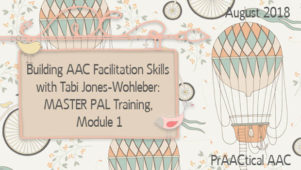
Are you… Hoping to train team members to be better communication partners for their AAC students/clients but overwhelmed by the thought of all the preparation? Relatively new to AAC and not sure what content to share in your training? Looking for additional resources to utilize in your existing training sessions? Good news, AAC friends! This post is for you. We’re so happy to have SLP Tabi Jones-Wohleber returning to the blog to share more of her wonderful AAC resources. Tabi works with young children at the West Virginia Birth to Three program and serves on the AT Team for Frederick County Public Schools in Maryland. Today, she launches a new series on partner training that focuses on the use of aided language input and other facilitative strategies. There are 11 modules in all (1 overview for administrative discussions and 10 for communication partners) and each one includes slides, handouts, discussion prompts, links... [Read More...]
August 22, 2018
by Carole Zangari -
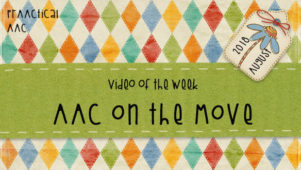
By bus, train, or subway, people with AAC needs have places to go and things to do. Today’s video features a successful effort in Victoria, Australia to provide communication access in public life. In this video, we see an example of how transportation agencies worked with Scope’s Communication and Inclusion Resource Centre to better meet the communication needs of people who use AAC. You can read more about their Communication Access program here. Many thanks to Scope, Public Transport Victoria, V/Line, and ISAAC for making this video available. It is sure to inspire similar efforts throughout the world. You can download some of the communication materials here. Direct Link to Video: https://www.youtube.com/watch?v=8TELuzDlgqo
August 15, 2018
by Carole Zangari -
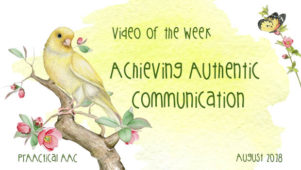
Looking for ways to help your team strengthen their AAC practices? Lots of families and professionals are on a journey to provide better AAC support and today’s featured video has information and tips that may help. You can get the handouts for this presentation here. Many thanks to Stephanie Reed and Saltillo for making this available. Direct Link to Video: https://www.youtube.com/watch?v=LvX8Y-pi5Ws
August 1, 2018
by Carole Zangari -

From the heights of a Ferris Wheel to fun places to shop, the Variety Western Australia Teen Motor Mouth Campers show us their stuff in this wonderful video which was presented recently at the 2018 ISAAC Conference. “AAC goes everywhere.” Indeed. Enjoy the laughter, smiles, and successes of Let’s Hit the Town. Many thanks to Variety WA Teen Motor Mouth Camp and ISAAC for this gem of a video! Direct Link to Video: https://www.youtube.com/watch?v=DNAzF6tKOb









